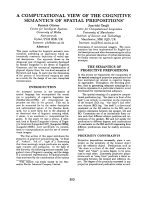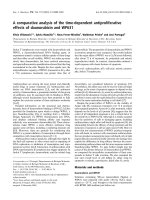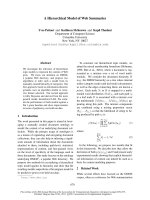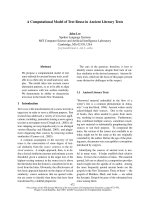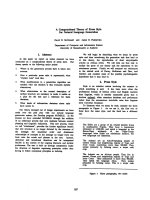Báo cáo khoa học: "A COMPUTATIONAL MODEL OF THE SYNTAX-PROSODY INTERFACE IN TOKYO JAPANESE" doc
Bạn đang xem bản rút gọn của tài liệu. Xem và tải ngay bản đầy đủ của tài liệu tại đây (628.98 KB, 8 trang )
WHAT SORT OF TREES DO WE SPEAK?
A COMPUTATIONAL MODEL OF THE SYNTAX-PROSODY INTERFACE
IN TOKYO JAPANESE
Pete Whitelock
Sharp Laboratories of Europe Ltd.
Neave House, Winsmore Lane
Abingdon, Oxon., OX14 5UD, Britain
ABSTRACT
What is the relationship between syntax,
prosody and phonetics? This paper argues for a
declarative constraint-based theory, in which each
step in a derivation adds diverse constraints to a
pool. Some of these describe well formed objects in
the feature structure domain, in terms of both
syntactic and prosodic features. Some characterise
the relative prominence of constituents as a partial
order over some discrete domain (playing the role of
metrical grid). Some are simultaneous equations in
the reals, whose solutions represent the pitch level of
phonetic objects - high and low tones. The elements
of such a theory are illustrated with a treatment of
prosodic phrasing and tone scaling in Tokyo
Japanese, and the theory is compared to Selkirk and
Tateishi's analysis based on the Strict Layer
Hypothesis.
INTRODUCTION
In explorations of the relationship between
syntax, phonology and phonetics, it is now generally
agreed that hierarchical prosodic representations
are an important organising concept. As
Pierrehumbert and Beckman (P&B, 1988), vividly
put it 'We speak trees, not strings'. One influential
view of the geometry of ~ree representations is
Selkirk's (1981) Strict Layer Hypothesis. For Selkirk
and others, prosodic structures and syntactic
structures are objects of different kinds. Yet the
nature of the mapping between them remains a
question to which explicit, accurate and declarative
answers have still to be formulated.
This paper presents an alternative view in which
phonetic constraints are incrementally associated
directly with syntactic derivations. More exactly,
derivations must simultaneously meet the well-
formedness conditions on syntactic and prosodic
labelling, thereby guaranteeing the declarative
nature of the syntax-prosody interface. In turn,
prosodic labels are associated with a set of
equational constraints on phonetic objects. The
theory is illustrated with a treatment of prosodic
phrasing and tone scaling in standard, i.e. Tokyo,
Japanese.
The possibility of equating syntactic and
prosodic structure in this way follows from a view of
syntax with two characteristics. First, some
commonly assumed syntactic constituents which
never correspond to prosodic units are insufficiently
motivated, so such constructions are given an
alternative syntactic analysis which respects
prosodic constituency. Secondly, the derivation of an
expression with a given semantic interpretation, and
hence its prosodic structure, may be systematically
under-determined by that interpretation. Syntactic
structure is thus at least partly motivated by
prosodic data, in accord with the concrete view of
syntax presupposed in constraint-based grammars.
Conversely, the results of Kubozono's (1987)
careful phonetic experiments point to the existence
of prosodic structures that are organised recursively
and in other ways incompatible with the Strict Layer
Assumption. Distinctions in syntactic constituency
which have been argued to be unimportant for
prosodic phrasing do appear to have clear phonetic
exponents under controlled conditions, weakening
the argument for autonomous prosodic structures.
The paper is organised as follows. The elements
of the syntactic model used in the analysis of
Japanese are presented. We then approach the
syntax-prosody interface from the opposite end, and
look at the prosodic phonetics of Japanese
utterances, trying to classify features of pitch
contours. First, several relatively uncontroversial
elements in the phonology of Japanese prosody are
discussed - the minor phrase, the accentual and
phrasal tones, declination and downstep. Then the
Strict Layer Hypothesis and its application to minor
phrasing and tone scaling are considered. Data from
Kubozono (1987) is introduced to argue instead for
the theory assumed here, and a preliminary
treatment is presented.
A CATEGORIAL UNIFICATION APPROACH
TO JAPANESE
I will identify the fundamental unit of Japanese
syntax with the traditional category~
bunsetsu
(phrase), comprising an open-class "item with
- 75 •
cliticised closed-class affixes. The open class lexical
items are broadly classifiable as nouns and verbs. As
described in Whitelock (1987), the closed-class
items may be classified in two orthogonal
dimensions. First, they form phrases with items of a
certain category. Second, they indicate that such a
phrase stands in some syntactic relationship (e.g.
subject, modifier) to another phrase with a certain
category. Thus the phrases of the language fall into
the following four categories:
nominal - adverbial, e.g.
keiko ni (Keiko-DAT), genki ni (healthily)
nominal - adnominal
keiko no (Keiko-GEN), g~nki na (healthy)
verbal - adverbial
waratte (laugh-and), amaku (sweetly)
verbal - adnominal
warau (that laughs), amakatta (that was sweet)
The
bunsetsu
generally behaves as a prosodic
unit. Although the syntactic structure of a phrase
like (1) is generally taken to be as in (la), its prosodic
structure must be as in (lb).
(i) Naoko no ant no
Naoko's brother 's
(la) [[[Naoko no] ant] no]
(ib) [[Naoko no] [ant no]]
Proposals to handle such 'bracketing
paradoxes' have been made within the framework of
extended Categorial Grammar (e.g. Moortgat, 1989).
We will assume a Categorial Unification Grammar
(CUG) (Uszkoreit (1986), Kartunnen (1987)).
Whereas an extended CG might capture the
polymorphism of a
bunsetsu
by the derivation step
of type-raising, in CUG it may be represented
simultaneously by the use of multiple features in the
complex categories. Syntactic bracketings such as
that shown in (la) are never assigned.
Each complex category or sign includes a set of
self features, plus the sign-valued features
argument
and result, which together with a
direction constitute a function. The relevant
structure of a typical sign, for the bunsetsu
keiko hi,
is shown in (2).
(2) self:[l]cat:n
function:arg: [2]self:cat:s
dir:right
res: [2]self:iobj:[l]
This sign says 'if a functor is looking for me, it
probably needs to know I'm a noun. But 1 am also a
function from a sentence of which I am the indirect
object into itself'. Note the assumption that well-
formedness of the functional representations (i.e.
those which include subj, obj etc.) is independently
characterised (cf. Coherence and Completeness in
LFG (Kaplan and Bresnan, 1982)). This leads to a
massive simplification in the combinatorial syntax.
Karttunen (1987) proposes a similar treatment for
Finnish. Furthermore, I treat free verb forms as S, an
approach motivated by the zero-pronominal
property of Japanese (see Whitelock 1991 for further
details). Also note,
contra
other work in extended CG
(e.g. Barry and Pickering (1990)), that this
formulation identifies the function in a
combination with the dependent in a functional
dependency representation, and the argument with
the
head.
The syntactic rules define three ways of building
signs. (3) shows rule A (essentially function
application) in PATR-II notation.
(3) M ) D,H (A)
<D function dir> = right
<D function arg> = H
<D function res> = M
The backward version of this rule (L) is the rule
of morphological combination. Unlike a syntactic
functor, a morphological functor, i.e. an affix, will
typically have quite distinct values of <function arg>
and <function result>.
The chaining rule (C) in (4) constructs the
• mother sign with self features from the functor sign
• rather than the result sign.
(4) M ) D,H (C)
<D function dir> = right
<D function arg> = H
<D function res function>
= <M function>
<D self> = <M self>
Finally, the merging rule (M) in (5) combines
two functors looking for the same argument:
(5) M ) D1 , D2 (M)
<DI functor> = <D2 functor>
<DI functor> = <M functor>
<M self> = nil
Though the details are specific to Japanese, it is
possible to develop rules of these types for other
76 -
languages. Like an extended CG, but unlike the
Lambek calculus, CUG is not structurally complete
(i.e. not every substring may be given an analysis).
Merging and chaining both correspond
approximately to composition in extended CG.
However, the CUG formulation brings out the
essential difference between them. A constituent
built by chaining represents a head lacking a
dependent, while merging combines dependents
lacking a head. Their effect on derivation depends
on the headedness of the language concerned. The
main effects are summarised in Fig. 1 (where <=>
denotes truth equivalence).
left-branching right-branching
language language
Fig. 1 Derivationa! Equivalence
The important aspects of this model are as
follows. First, all structures are directly generated by
the grammar. The <=> is not a rule for deriving one
structure from another. Secondly, the branching
structure may be sensitive tO constraints other than
semantic ones. In particular, applicatively right-
branching structures may be given alternative,
psychologically more plausible, analyses. Such
analyses are useful in modelling intonation
phenomena such as the prosodic bracketing of
English phrases like (6) (generated using the English
Chain rule), whose applicative bracketing is given in
(6a).
(6) [this is the dog][that bit the cat]
[that chased the raft[that
(6a) [this[is[the[dog[that[bit[the[cat
[that[chased[the[rat[that
THE PHONETICS OF PROSODY
180
-
•0@@~
•@
@@•@ • • • •
• 0@0
140 -
• e •• •
no mi m• no•
so re wa u ma .'i
i00 -
Fig. 2 A pitch trace
Fig. 2 shows a pitch trace for the Japanese
utterance (7) which will be used to introduce the
major features of the prosodic organisation of the
language.
(7) Sore-wa uma-i nomimono de-su
That-TOP tasty-PRES drink COP-PRES
That is a tasty drink.
O • oee 4
f
so re wa
i
" )
u ~ i
"@• •
( I~
_.
so no
Fig. 3a Minor Phrases
In Fig 3a, the division of the utterance into
minor phrases (~t) (P&B's accentual phrase) is
highlighted. A minor phrase shows exactly one pitch
peak; in this utterance, the minor phrases
correspond exactly to bunsetsu. In the section on
minor phrasing below, we will look more closely at
the relationship between the two.
• H H* k
so re wa u ma i no mi m• nL~
Fig. 3b Tones and Accent
Fig. 3b draws attention to the distinction in
shape between the first and the latter two minor
phrases. The steep drop in pitch from
ma
to i in
umai,
and from
mi
to
m•
in
nomimono,
represents
the pitch accent proper. The presence and location
of a pitch accent is a lexical property, and its shape is
fixed. In contrast, the gentle fall covering 'the
rewa
of
sorewa
is a result of
sore's
lexical specification as
unaccented. In such cases, a lower pitch peak than
the accented one is realised early in-the minor
phrase. In fact, in minor phrases with a late accent,
this early peak is also distinguishable, so this
"phrasal' tone can be assumed present in all minor
phrases. Note the phonetic justification of this
prosodic category as the domain of high tone
linking.
- 77 -
The diagram is annotated according to the
notation of Pierrehumbert (1980). The pitch accent is
represented as a sequence of tones, here H+L, with
the tone that is aligned with the text marked *, hence
H*+L. The L tone of the accent is aligned with
respect to this. The phrasal H tone and the boundary
L tones, L%, are also shown. P&B clearly
demonstrate that their sparse tone model, built from
pitch accents, phrasal H tones and boundary L
tones, is superior to the standard Autosegmental
account (e.g. Haraguchi, 1977), where each mora has
a fully specified tone. Their careful phonetic
experiments show that pitch is a simple
interpolation between certain critical points.
In this paper, the alignment of tones will not be
considered. In English, the repertoire of pitch
accents leads to phrases with a variety of tunes,
including alignment contrasts such as that between
H+L* and H*+L. But in Japanese, the tunes are
restricted to the ones in (8).
(8) (L%) H (L%) unaccented
(L%) H H*+L (L%) accented
I have bracketed the boundary tones at both
ends to indicate that they belong to both preceding
and following phrases - they are ambiphrasal. More
exactly, I treat a boundary tone between two minor
phrases as a property of the major phrase which
dominates both of them, though I don't discuss L-
tone scaling in the paper.
In fig. 3c, the overall downward slope of the pitch
trace is picked out. Such a slope, about 10Hz/sec, is
often cited as an intonational universal and linked to
physiological properties of the speech system.
Experiments demonstrate that the second of two
equal tones is typically perceived as higher. This
phonetic property, declination, must be clearly
distinguished from the phonological property
downstep or catathesis, as also illustrated in fig. 3c.
J
w v
•
downstep
• ee••@ • u-
•0 @@
e•e
t
i o n •
• •
e
so re wa u ma i no mi me nee
Fig. 3c Declination and Downstep
The pitch difference between the accent H
tones of the last two phrases is significantly greater
than can be accounted for by declination alone.
Several authors (Poser, 1987, P&B, Kubozono) have
demonstrated that this effect occurs precisely
because an accent lowers all tones in a subsequent
phrase. P&B quantify the fact of downstep with a
speaker specific constant c, (,, 0.5, in a pitch range
normalised to 1). In effect, a tone in a phrase
following an accented phrase is c times the height it
would be following an unaccented phrase. The
prosodic category major phrase is justified
phonetically as the domain of downstep; the precise
character of major phrases is a point at issue in this
paper.
so re wa u ma i no mi me no
Fig. 3d Schematic Pitch Trace
Fig. 3d shows a schematisation of the same pitch
contour, correcting for declination and connecting
adjacent peaks and troughs with straight line
segments.
ordered finimsetofprosodic categories:
~,Hn >,forexample:
< prosodic word (CO),
minor phrase (~),
major phrase (4),
utterance(V)>
THE STRICT LAYER HYPOTHESIS
The Strict Layer Hypothesis posits a totally
< li0, •
Each local tree in a prosodic representation is
licensed by a phrase structure rule of the form
Hi "-~
Hi-l", for i E 1 n. Thus a
category of one
type dominates all and only the categories of
one
other type, and prosodic trees are fixed in depth and
n-ary branching.
Acceding to Selkirk and Tateishi (S&T, 1989) the
syntax-prosody mapping is then defined by
associating with each II b i E 0 n, a parameter pair
of the form:
< edge,
xbar>, edge E {left,right},
bar E BAR, i.e. {lex, max, }
- 78 -
The parameter settings entail that a prosodic
boundary between constituents of category H i must
coincide with the edge of a syntactic constituent of
category X bar . Note by SLH that a prosodic
boundary between Hi must also be a boundary
between Flj, for all j < i.
MINOR PHRASING
For S&T, the edge parameter for Japanese
prosodic categories is uniformly set to left. The X bar
value associated with the major phrase ((~) is X max.
Therefore, a major phrase boundary must appear at
the left edge of any maximal projection.
syntactic structure I
,&,,
.
A
NI no N2 ga prosodic
~ N1 structures
prosodic boundaries ~ ~
by S&T's SPI 0~ b)
Fig. 4 Minor Phrasing (S&T)
It is not easy to give such a straightforward
account of minor phrasing. Under certain
circumstances, a sequence Of two bunsetsu may be
realised as a single minor phrase. For S&T bunsetsu
is never a syntactic category, but rather appears as
the prosodic category word (0)). It is the prosodic
word rather than the minor phrase which has the
parameter setting, in this case X lex. So an upcoming
lexical item must initiate a prosodic word, but may or
may not initiate a minor phrase. The analysis is
summarised in fig. 4. One slight methodological
problem is that the prosodic word has no phonetic
justification.
In the alternative analysis pursued here, two
boolean-valued features major and minor are used
to prosodically classify syntactic constituents. A
single constituent may not be both <minor +> and
<major +>, though it may be neither. Each of these
feature specifications is associated with
characteristic phonetic equations. A constituent
labelled <minor +> will contribute a constraint that
relates the pitch of the H tones to the value of a
register. A constituent labelled <major +> will
contribute two sets of constraints - over the relative
values of its daughter's registers, and on the pitch of
the intermediate L% tones. These constraints are
discussed below.
The admissible prosodic labellings are defined
as those which extend the following prosodic rules.
in (9) (+(~), the mother is constrained to be a major
phrase, while in (10) (-4~), the mother is constrained
not to be a major phrase, though it may or may not
be a minor phrase.
(9) Mother -~ Left Right (+~)
<Mother major> = +
<Mother minor> = -
<Left major> =
<Left minor> = -~
<Right major> =
<Right minor> = -6
(i0) Mother -9 Left Right (-~)
<Mother major> = -
<Left major> = -
<Left minor> = -
<Right major> = -
<Right minor> = -
Note how the category major phrase is recursive
(or compound, in the sense of Ladd (1990)), while
minor phrase is a single layer.
The syntax-prosody interface (SPI) is defined as
a subset of <prosodic rules X syntactic rules>. For
instance, the optionality of minor phrase formation
follows from the inclusion of <+~),A> and <-4~,A> in
SPI.
syntactic structure
A
N made
phrasing
A
prosodic
structure?
Fig.
5 A problem for SLH
S&T assume that a minor phrase boundary may
never appear within a bunsetsu (£0). However,
Kubozono shows that such phrasings can occur,
when the phrase contains both an accented lexical
item and a particle with its own accent, such as
- 79 -
made,
'up to'. The SLH cannot license structures as
in fig. 5. In the theory assumed here, this data is
simply described by the inclusion in SPI of <+(~,L>
as well as <-~,L>.
TONE SCALING
Two-element phrases:
When two minor
phrases are combined, the accentedness of the first
element provides the strongest constraints on the
form of the second - if the first element is accented,
the second element is downstepped. In addition, an
accented element is higher than an unaccented one
(this is true of previous L% tones as well as H tones).
We associate with the prosodic rule +(~ a scaling
equation as in (11):
(ii) Mother -~ Left Right (+¢)
<Right register> =
f (<Left register>,
<Right downstep>)
If the values of these features are real,
normalised to speaker range, and f is multiplication,
this treatment is very similar to P&Bs. I assume the
feature <Right downstep> takes the values d n (n >
0), where n is the number of downstepping tones in
Left and d is the speaker specific constant (<1) that
determines the quantitative aspects of downstep.
For each constituent Phrase labelled <minor
+>, a set of equations as in (12) is added to the
constraint pool:
(12) <Phrase accent pitch> =
<Phrase register>
<Phrase phrasal high pitch> =
g(<Phrase register>,u)
This continues to follow P&B (with g =
multiplication) and u (<1) a speaker constant
representing the ratio of phrasal to accent high.
Three-element phrases:
Kubozono considers
three element phrases and contrasts the intonation
of those with right and left branching applicative
structures. For instance, fig. 6 contrasts the two cases
in (13), in which all elements are accented. The
difference between the second peaks in the two
structures is significant at < 1%, the difference
between the third at <.1%.
(13a) ao'i o'okina me'ron (right branching)
blue big melon
(13b) ao'i re'monno nio'i (left branching)
blue melon smell
Fig. 6 Three-element Phrases
To describe this, I assign a metrical labelling to
a derivation. I assume that
contra
English,
the
primary phonetic exponent of such labelling in
Japanese is pitch, that is, the H tones in stronger
constituents are higher. The labelling associated
with the A (and C) rule is as follows:
In a structure of the form:
[A X Y] or [C X Y]
Y is strong iff it branches
This gives the following labellings for the trees in
fig. 6.
a) [W IS S WI] b) [Is S W] W]
Labelling rules may of course be overridden by
discourse factors. Space precludes a detailed
description of prominence projection, that is, the
correlation of metrical labelling with discrete
terminal grid values. Note that the standard
Liberman and Prince convention equates the grid
values of the last element in the two cases, in conflict
with the data. One formulation would assume a
feature, say prominence, which takes the values 1
or p (>1) as a constituent is labelled W or S.
Downstepping and prominence interact, with the
formulation in (14) replacing that given in (11) above:
(14)
<Right register> =
f(<Left register>,
<Right downstep>,
<Right prominence>)
<Left register> = <Mother register>
Note that the register of a constituent is that of
its left daughter. If the entire phrase is given
the
register value 1, and f is multi-plication, the
high
tones in fig. 6 receive the following pitch values.
Right-branching case
H2 = HI * d * p = d * p
H3 = H2 * d = d 2 * p
Left-branching case
H2 = HI * d * 1 = d
H3 = HI * d 2 * 1 = d 2
- 80 .
These figures capture the fact that both second
and third elements in the right-branching structure
~re boosted with respect to their left-branching
counterparts.
S&T's data shows the same effect as that of
Kubozono in fig. 6. Their analysis is schematised in
fig. 7. The difference between the two cases follows
from the binary opposition downstep/no downstep.
However, this analysis is no longer supported by
Selkirk (p.c.), following Kubozono's clear demon-
stration that downstep does apply in right-branching
phrases. If the first element of a right branching
phrase is unaccented, the second element is even
higher.
V V
~ = downstep ~= no downstep
Fig. 7 Three-Element Phrases (S&T)
Four-element phrases: When we turn to four-
element phrases, we find further evidence for
i~ecursively structured prosodic domains. Fig. 8
summarises Kubozono's data. All trees represent
applicative structures. In structures 1 and 2, the first
two elements are a dependent and its head,
indisputibly a constituent. In structures 3 and 4, the
first two elements are dependents of the same head.
This is a non-standard constituent built by the
Merge rule. Syntactically, such a constituent
appears in coordinate sentence constructions with
"gapped' pre-final verbs. Finally, in structure 5, the
first two elements do not form a syntactic constituent
of any sort, being a head and the dependent of
~iifferent head.
These functional equivalence classes correlate
closely with the relative heights of the two pitch
peaks the tighter the connection between the two
elements, the lower the second peak. This account
compares favourably with other theories that only
postulate one such relationship, such as Lambek
grammar where every pair of phrases is a
~:onstituent, or those with two, such as phrase-
8~ructure grammar, or Barry and Pickering's (1990)
ve~'sion of Lambek with dependency and non-
~ependency constituents.
However, in principle Barry and Pickering's
model could generalise as follows. They characterise
any string whose analysis involves abstraction over a
function symbol as a non-dependency constituent.
But as many further distinctions as the data warrants
may be made by considering the number of functors
abstracted over. Kubozono's data for four-element
phrases supports the case for at least three
distinctions (no functor abstraction, one, more than
one). Whether further distinctions need to be
supported is unclear, as the systematic phonetic
exploration of five-element phrases has yet to be
carried out.
Fig. 8 Four-Element Phrases
CONCLUSIONS
A constraint-based model of syntax and
prosodic phonetics has been introduced and
analyses of Japanese phonological phenomena have
been outlined. Space precludes detailed
consideration of the model's application to other
dialects and languages. However, a similar model
has been argued for by Briscoe (pc) on the basis of
English.
The model has been implemented in a Prolog
version of PATR-II augmented with a simultaneous
equation solver. Most of the data given above have
been described with varying degrees of accuracy.
Formulating and testing the predictions of diverse
hypotheses with the system is easy due to the basic
generative approach. Further cycles of phonetic
experiments and modelling of the results are
needed to distinguish between alternative analyses
and refine the accuracy of the model.
-81 -
If this early exploration turns out to be on the
right track, and it is indeed possible to describe the
prosodic properties of speech within an integrated
declarative model of grammar, then future speech
synthesis systems will be able to exploit diverse
information on-line in the generation of natural
intonation.
ACKNOWLEDGMENTS
This work was carried out while I was a visiting
fellow at the Centre for Cognitive Science, University
of Edinburgh. I would like to thank Ewan Klein for
making this possible. I am grateful to all the
members of the Phonology workshop, especially Bob
Ladd who read and commented on earlier drafts. Jo
Calder and Mike Reape had me as an office mate,
and helped me in all sorts of ways, so special thanks
to them.
REFERENCES
Barry, Guy and Martin Pickering (1990)
Dependency and Constituency in Categorial
Grammar. in Edinburgh Working Papers in
Cognitive Science,
Voi. 5: Studies in
Categorial
Grammar,
G. Barry and G. Morrill (eds.). Centre for
Cognitive Science, Univ. of Edinburgh.
Haraguchi, Shosuke (1977) The Tone Pattern
of Japanese: An Autosegmental Theory of
Tonology. Kaitakusha, Tokyo.
Kaplan, Ronald and Joan Bresnan (1982) Lexical
Functional Grammar: A Formal System for
Grammatical Representation. in The Mental
Representation of
Grammatical Relations,
J.
Bresnan (ed.) MIT.
Karttunen, Lauri (1989) Radical Lexicalism. in
Alternative Conceptions of Phrase Structure,
M.R. Baltin and A.S. Kroch (eds.), Chicago.
Kubozono, Haruo (1987) The Organization of
Japanese Prosody PhD Thesis, Dept. of
Linguistics, Univ. of Edinburgh.
Ladd, D. Robert (1990) Compound Prosodic
Domains, submitted to Language.
Moortgat, Michael (1989) Categorial
Investigations: Logical and Linguistic Aspects
of the Lambek Calculus. Forts, Dordrecht.
Pierrehumbert, Janet (1980) The Phonology
and Phonetics of English Intonation. Doctoral
diss. MIT.
Pierrehumbert, Janet and Mary Beckman (1988)
Japanese Tone Structure,
MIT Press, Cambridge.
Poser, William J. (1984)
The Phonetics and
Phonology of
Tone and
Intonation in Japanese.
Doctoral diss. MIT.
Selkirk, Elisabeth (1981) On Prosodic Structure
and its Relation to Syntactic Structure, in
Nordic
Prosody
vol. 2, ed. T. E. Fretheim, Tapir,
Trondheim.
Selkirk, Elisabeth and Koichi Tateishi, (1989)
Constraints on Minor Phrase Formation in Japanese,
in Proceedings of
the CLS
24.
Uszkoreit, Hans (1986) Categorial Unification
Grammars. COLING 11, Bonn.
Whitelock, Peter J. (1987) A feature-based
categorial morpho-syntax of Japanese. in Natural
Language Parsing and Linguistic
Theories, U.
Reyle and C. Rohrer (eds.) Reidel, Dordrecht.
Whitelock, Peter J. (1991) Some Aspects of a
Computational Grammar of Japanese,
forthcoming PhD thesis, Dept. of Language and
Linguistics, UMIST.
- 82 -

